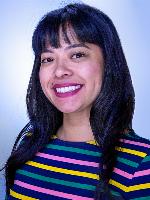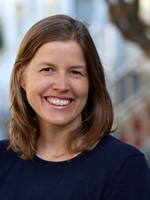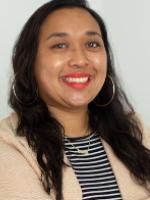

Start With Teachers as Creators to Build Student Media Literacy |
Participate and share : Interactive session
Jamie Galgana Allison Jonas Rachel Roberson Angelica Valerio
As tech tools become more accessible, let’s embrace the next step: integrating media-making in classrooms to center student voice and creativity. Get hands-on with LAUSD's Instructional Technology Initiative and public media’s KQED and learn how they partnered to support 32 Practitioner Schools to integrate media projects PK-12.
| Audience: | Coaches, Teachers, Technology coordinators/facilitators |
| Skill level: | Beginner |
| Attendee devices: | Devices required |
| Attendee device specification: | Laptop: Chromebook, Mac Tablet: Android, iOS, Windows |
| Topic: | Professional learning |
| Grade level: | PK-12 |
| ISTE Standards: | For Educators: Designer
Creative Communicator
|
Supporting students to become creative communicators in a variety of media formats is vital to building 21st century skills across grade levels and content areas. The Covid-19 pandemic got devices into more students’ hands than ever before. Yet, as technology tools and online apps become more accessible, it’s time to embrace the next step: How to fully integrate media-making into the curriculum in a way that centers student voice, creativity and self-expression. Media projects open doors beyond the classroom, making it possible for students to connect with peers and encounter multiple perspectives. This type of connection is more important than it’s ever been, strengthening both social-emotional learning and content knowledge. Classroom teachers and school-level leaders need support to meaningfully make student-created media a central part of the curriculum, along with community partners committed to sharing media literacy expertise and publishing youth voices to a wider audience. In the 2021-22 school year, KQED and Los Angeles Unified School District’s Instructional Technology Initiative partnered to support instructional coaches and site leaders in the 32-school Practitioner School network to meaningfully integrate media projects across grade levels (K-12), and provide opportunities for the podcasts and video documentaries created by middle and high school students to reach a wide audience through KQED’s Youth Media Showcase and Southern California public media stations.
This hands-on, interactive session will model how KQED media literacy instructors and LAUSD technology integration coaches supported Practitioner School teachers and site leaders in creatively communicating with media (audio storytelling, in this case) across subject areas and grade levels. Using a learn-by-doing approach, session participants will analyze student-created audio stories, explore examples from the Practitioner School network of how to make meaningful connections between audio storytelling and subject area or classroom context, and use Soundtrap for Education to create an audio story designed to build classroom community and strengthen production skills.
The ability to access, analyze and create media are three key components of media literacy. In this session, participants will explore all three of these components through the lens of audio storytelling across the curriculum. Modeled on sessions drawn from the year-long partnership between LAUSD’s Practitioner School Network and KQED’s coaching sessions, participants will:
5 minutes: Meet the facilitators and connect to fellow participants through shared experiences of audio storytelling (ie: popular podcasts, historic radio programs, etc.)
15 minutes: Analyze student-created audio stories that were created by Practitioner School students and shared beyond the classroom on KQED’s Youth Media Showcase and public media stations-
15 minutes: Explore and discuss examples of how Practitioner School teachers integrated audio storytelling across grade levels and subject areas (PK-12)
40 minutes: Create a “quick podcast” designed to build community and strengthen audio production skills using Soundtrap for Education (no-cost access provided by KQED)
10 minutes: Reconnect and close
Please note: This session can be modified to fit a 60-minute format.
Garcia, A. et al (2014) Teaching in the Connected Learning Classroom. Irvine, California: Digital Media and Learning Research Hub.
Jenkins, H., et al. (2009). Confronting the Challenges of Participatory Culture: Media Education for the 21st century. Cambridge, Massachusetts: The MIT Press.
Ito M. et al (2019). Hanging Out, Messing Around, And Geeking Out, Tenth Anniversary edition: Kids Living and Learning with New Media. Cambridge, Massachusetts: The MIT Press.
Ito, M., et al. (2013). Connected Learning. Irvine, California: Digital Media and Learning Research Hub.
Vander Ark, Todd and Schneider, Carri. Deeper Learning for Every Student Every Day. A report from the William and Flora Hewlett Foundation.


Jamie is a Specialist for Instructional Leadership Support with the Instructional Technology Initiative. She supports L.A. Unified educators and leaders in leveraging digital tools and resources for student success through various models of support, including working with Practitioner Schools, supporting Professional Development, and assisting with ITI’s Signature Events. Jamie was an elementary teacher for 10 years, and EdTech Coach for 2.5 years, and is currently an Administrative Specialist. Jamie has a masters in Elementary Mathematics and a Preliminary Administrative Services Credential. She’s a Google Certified Trainer, Microsoft Innovative Educator, Common Sense Certified Educator and Ambassador, and a Prosci Certified Change Practitioner.

Ms. Allison Jonas currently serves as an Readiness and Integration Coordinator for the Los Angeles Unified School District. Ms. Jonas has over 20 years of teaching experience and a strong commitment to student growth, development, and academic success. Her expertise rests in providing Instructional Technology leadership, including visioning, strategic planning, goal-setting, curricular innovation, program evaluation, problem-solving, and utilizing management theory and practice.

Rachel Roberson, KQED’s program manager for humanities professional learning, is an experienced classroom teacher and teacher leader. She leads KQED’s synchronous professional learning strategy and content. She is also an instructor and course developer for KQED's Media Academy for Educators where she supports educators in integrating media literacy into classrooms. Rachel was founding English teacher and assistant principal of KIPP Bayview Academy in San Francisco and has taught middle school English, ELD and social studies in Austin, Texas, and internationally. Before becoming a teacher, she was a journalist in the Bay Area.

Angel Valerio is KQED’s program manager for STEM education professional learning and a secondary science field supervisor for Mills College’s teacher education program. She leads professional development workshops with the focus on incorporating media literacy in science instruction and is an instructor and course developer for KQED’s Media Academy for Educators. Angel has presented workshops on media production in science at the California STEAM Symposium, CUE and to various school districts in California. Previous to her current roles, Angel worked in South Los Angeles and East Oakland as a high school life science educator, teacher leader, and instructional coach.
Applying PBL to Environmental Science To Address Authentic Problems
Connected teaching and learning with Canvas LMS and Microsoft Teams
Taking PBL From Good to Great: Aim for Impact With Authentic Challenges